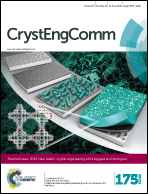Unique (3,9)-connected porous coordination polymers constructed by tripodal ligands with bent arms†
Abstract
Solvothermal reactions of Co(NO3)2 with tripodal ligands 3,3′-([3,4′-bipyridine]-2′,6′-diyl)dibenzoic acid (H2L4), 3,3′-([4,4′-bipyridine]-2,6-diyl)dibenzoic acid (H2L5), and 2,6-bis(4-(1H-tetrazol-5-yl)phenyl)-4,4′-bipyridine (H2L6) possessing one to three bent arms, yielded three new porous coordination polymers, namely [Co3(μ3-OH)(L4)3] (1), [Co3(μ3-OH)(L5)3] (2), and [Co3(μ3-OH)(L6)3] (3), respectively. Single-crystal X-ray crystallography showed that 1–3 are all three-dimensional (3,9)-connected coordination networks interconnected by the tripodal ligands and the classical tricapped trigonal-prismatic [Co3(μ3-OH)(RCOO)6(Py)3] (Py = pyridyl) or new tricapped trigonal-prismatic [Co3(μ3-OH)(Rtz)6(Py)3] (Rtz− = tetrazolate) clusters. However, instead of the classical xmz topology for such a kind of 3-connected ligands and 9-connected clusters, 1 and 2 show a new (3,9)-connected topology, wys, with a point symbol of {42·6}3{46·627·83}, while 3 has a (3,9)-connected eee topology. Thermogravimetry, powder X-ray diffraction, and gas adsorption measurements demonstrated that the desolvated forms of 1–3 are all porous, but different framework flexibilities were observed.

- This article is part of the themed collection: 2016 New talent

 Please wait while we load your content...
Please wait while we load your content...